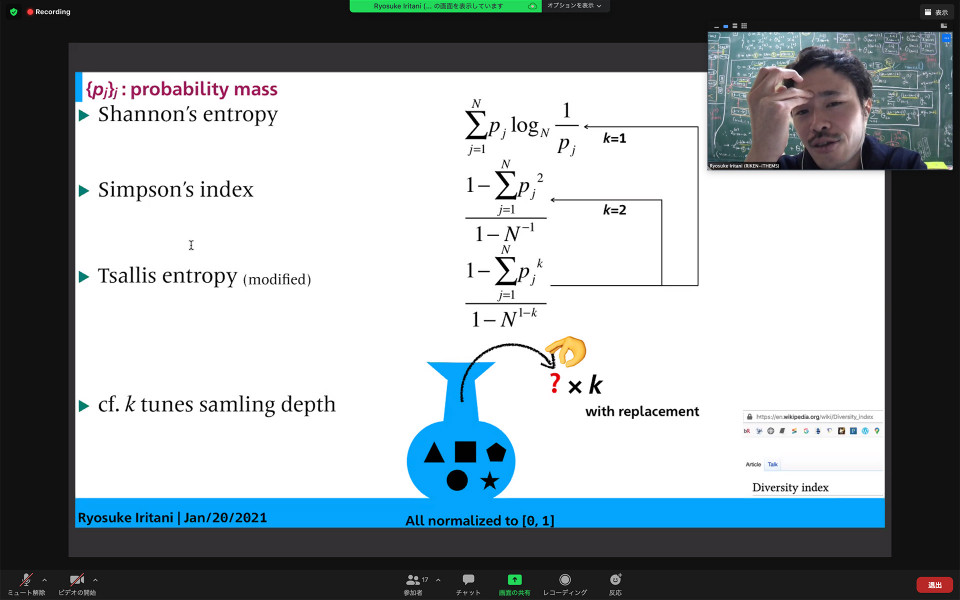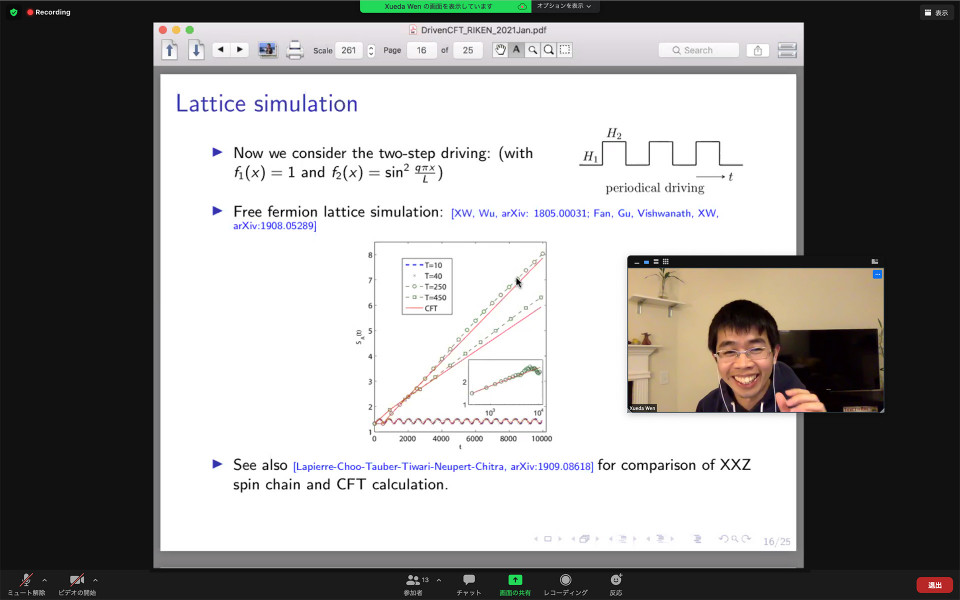Volume 134
Back to Newsletter List
Hot Topic
Dr. Ozawa’s interview published in Israeli magazine “Epoch”
2021-01-15
The Israeli popular magazine “Epoch” has featured Dr. Tomoki Ozawa, AIMR Junior Principal Investigator, in its December 2020 issue.
The feature article describes his research on synthetic dimensions. Although we live in a three-dimensional space, scientists can now “artificially” create and study the equivalent of dimensions, which is different from ordinary ones.
Dr. Ozawa uses “spin” of an atom as an example of a synthetic dimension. By using spin degrees of freedom as an additional dimension, it is possible to study higher dimensional physical phenomena, such as the four-dimensional quantum Hall effect.
The article was published for the general public focusing on cutting-edge research on higher dimensions, also discussing their relations to science-fiction like parallel universe. The article contains an easy-to-follow description of the new idea of synthetic dimensions, which is accessible to general readers. We expect that the studies on synthetic dimensions to have impacts in a variety of fields, ranging from condensed matter physics to high-energy physics.
Seminar Report
Biology Seminar by Dr. Koichiro Uriu on January 7, 2021
2021-01-21
On January 7th, Dr. Koichiro Uriu gave a talk on one of the most important pattern formation in our body. Koichiro was an active member of iTHES, and is currently an assistant professor at Kanazawa Univ. Rhythmic (ON and OFF) and also spatial gene activity pattern, termed the segmentation clock underlies our body axis segmentation (“Taisetsu" in Japanese). Thus, robust gene activity oscillation propagates from the backward to the forward domain by which the segment is formed sequentially. In the seminar, Koichiro discussed the recovery processes of the segment formation after the removal of the drug which blocks oscillator coupling in a fish, called zebrafish. Curiously, experiments show that intermingled segments can occur in the body of the fish especially when the drug is removed at early stage. To understand the pattern recovery, he developed a physical model incorporating mechanics and genetic oscillations. During and after the talk, there were numerous questions from the audience because his talk was very interesting and also very clear. Thank you and see you, Koichiro!
- Gen Kurosawa
From local resynchronization to global pattern recovery in the zebrafish segmentation clock
January 7 (Thu) 10:00 - 11:00, 2021
Seminar Report
Information Theory SG by Dr. Ryosuke Iritani on January 20, 2021
2021-01-20
On January 20th, Dr. Ryosuke Iritani gave us a talk about his motivation to work with information theory. He first formulated the dynamics of species-site data in ecology as a Markov model. By reducing the model to a simpler one in an elegant way, he analytically obtained the evolution of the proportion of species. In addition, he discussed certain entropies that characterize the diversity of species and showed us the unique dynamics of the entropy in his model. His talk was clear as he explained mathematical concepts by using simple examples and illustrations, and there were questions and comments from several viewpoints. We are thankful to Ryosuke for the exciting talk!
Kyosuke Adachi (BDR/iTHEMS)
Information theory in ecology: Markov chain, Venn diagram, Kronecker (and Cartesian graph) products, and Tsallis entropy
January 20 (Wed) 13:00 - 14:00, 2021
Seminar Report
First Quantum Matter Seminar by Dr. Xueda Wen on January 18, 2021
2021-01-19
We are happy to invite Dr. Xueda Wen from Harvard University to give a talk on January 18th. This talk is the first seminar of the quantum matter study group. The topic is time-dependent driven quantum critical systems in (1+1) dimensions, which connects condensed matter physics and high energy physics. Dr. Wen started with two different free-fermion lattice Hamiltonians. The system is driven periodically and alternatively with these two Hamiltonians. Interestingly, this driven system leads to two distinct two phases. This straightforward introduction smoothly brought us to the study of time-dependent driven conformal field theories. The driven CFTs show that the periodical driving systems can possess heating and non-heating phases, and the phase transition boundary separates these two phases. Dr. Wen further talked about the generalization of driving CFTs and several unsolved problems.
This talk is informative as well as interactive. Drs. Tada, Hongo, and Takasan asked several key questions, and Dr. Wen answered those questions clearly and informatively. We thank Dr. Wen for the great talk.
Reported by Ching-Kai Chiu
Time-dependent driven quantum critical systems in (1+1) dimension
January 18 (Mon) 10:00 - 11:15, 2021
Upcoming Events
Seminar
iTHEMS Theoretical Physics Seminar
Many body problems from quarks to stellar evolutions
January 28 (Thu) 13:30 - 15:00, 2021
Nobutoshi Yasutake (Associate Professor, Chiba Institute of Technology)
The many-body problems are major problems that need to be clarified not only in nuclear physics, but also in astronomy. In this seminar, I introduce stellar evolutions as gravitational many-body problems, and also hadronic matter as quantum many-body problems, based on the Lagrangian schemes. The macroscopic stars and the microscopic hadronic matter look completely different issues. But in this seminar, I introduce the similarities between the two problems. For hadronic matter, we adopt the color molecular dynamics to understand the behaviors and properties of hadronic matter in the framework of QCD. Although molecular dynamics can not be the first-principle, they are sometimes useful to understand many-body quantum properties. In this talk, we introduce the current status of our color molecular dynamics.
Venue: via Zoom
Event Official Language: English
Seminar
iTHEMS Theoretical Physics Seminar
Quantum kinetic theory for chiral and spin transport in relativistic heavy ion collisions and core-collapse supernovae
February 4 (Thu) 13:00 - 14:30, 2021
Di-Lun Yang (Assistant Professor, Faculty of Science and Technology, Keio University)
Recently, the anomalous transport phenomena of relativistic fermions associated with chirality and spin induced by external fields have been greatly explored in different areas of physics. Notably, such phenomena are in connection to various quantum effects such as quantum anomalies and spin-orbit interaction. The quark gluon plasmas produced from relativistic heavy ion collisions (HIC) and the core-collapse supernovae (CCSN) are both the systems in extreme conditions with high temperature or density and the presence of strong magnetic and vortical fields. Meanwhile, the abundance of light quarks and neutrinos as relativistic fermions created therein accordingly makes these two systems ideal test grounds for studying such exotic transport phenomena. Inversely, the anomalous transport may also give rise to unexpected impacts on the evolution of both systems. However, to analyze such dynamical quantum effects, a novel quantum transport theory delineating the evolution of chirality imbalance and spin has to be introduced. In this talk, I will discuss recent developments and applications of the quantum kinetic theory for chiral and spin transport in the context of HIC and CCSN.
Venue: via Zoom
Event Official Language: English
Workshop
Co-hosted by iTHEMS
The 12th RIKEN-Kyoto University Joint Data Assimilation Workshop
February 10 (Wed) 13:30 - 16:30, 2021
Language: Japanese/English
Participation deadline: Tuesday, February 9, 2021
Venue: via Online
Event Official Language: Japanese
Seminar
iTHEMS Theoretical Physics Seminar
Quantum mechanical description of energy dissipation and application to heavy-ion fusion reactions
February 16 (Tue) 13:00 - 14:30, 2021
Masaaki Tokieda (Ph.D. Student, Department of Physics, Graduate School of Science, Tohoku University)
For theoretical description of heavy-ion fusion reactions, two different models have been used depending on the incident energy. At energies above the Coulomb barrier, importance of energy dissipation and fluctuation has been deduced from scattering experiments. To describe them phenomenologically, the classical Langevin equation has successfully been applied. At energies below the Coulomb barrier, on the other hand, the quantum coupled-channels method with a few number of internal states has been applied, and it has succeeded in explaining sub-barrier fusion reactions. While each method succeeds in each energy range, a unified description of heavy-ion fusion reactions from sub-barrier energies to above barrier energies is still missing. To achieve this, we need to treat dissipation and fluctuation quantum mechanically.
In order to describe dissipation and fluctuation quantum mechanically, we have applied ideas of open quantum systems to heavy-ion fusion reactions. I will talk about recent development in this talk. First I will introduce a model Hamiltonian to treat dissipation and fluctuation quantum mechanically, and explain its character and a strategy for numerical studies. I will then apply the model to a fusion problem, and discuss a role of energy dissipation during quantum tunneling. Finally I will discuss a possible future direction for a unified description of heavy-ion fusion reactions.
Venue: via Zoom
Event Official Language: English
Seminar
DMWG Seminar
Mapping the Milky Way by VLBI Astrometry
February 16 (Tue) 13:30 - 15:00, 2021
Nobuyuki Sakai (Korea Astronomy and Space Science Institute (KASI), Republic of Korea)
Astrometry is the only way to obtain 6D (position-velocity) phase space information for astronomical objects. The unique capability allows us to examine the past, present, and future of the Milky Way.
Firstly, I will introduce history and basics of astrometry. Secondly, I will overview astrometric projects in the world. Thirdly, I will highlight recent astrometric results about the Galactic structure. Lastly, I will introduce astrometric research in Korea as well as future astrometric projects and sciences in 2020s and 30s.
Venue: via Zoom
Event Official Language: English
Conference
Co-hosted by iTHEMS
Blockchain in Kyoto 2021
February 17 (Wed) - 18 (Thu) 2021
Language: Some parts will be in Japanese.
The International Conference on Blockchains and their Applications aims at bringing together researchers and practitioners from various communities of science and technology working on areas related to FinTech, Crypto-asset, and Blockchain.
For more information, please refer to the related links.
Venue: Hybrid Format (International Conference Room I, Clock Tower Centennial Hall, Kyoto University and Online)
Event Official Language: English
Paper of the Week
Week 4 of January
2021-01-21
Title: Second and fourth moments of the charge density and neutron-skin thickness of atomic nuclei
Author: Tomoya Naito, Gianluca Colò, Haozhao Liang, Xavier Roca-Maza
arXiv: http://arxiv.org/abs/2101.07680v1
Title: Exploring effects of tensor force and its strength via neutron drops
Author: Zhiheng Wang, Tomaya Naito, Haozhao Liang, Wen Hui Long
arXiv: http://arxiv.org/abs/2101.04860v1
If you would like to cancel your subscription or change your email address,
please let us know via our contact form.
Copyright © iTHEMS, RIKEN. All rights reserved.






